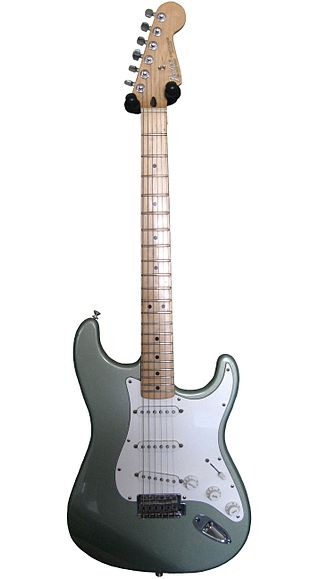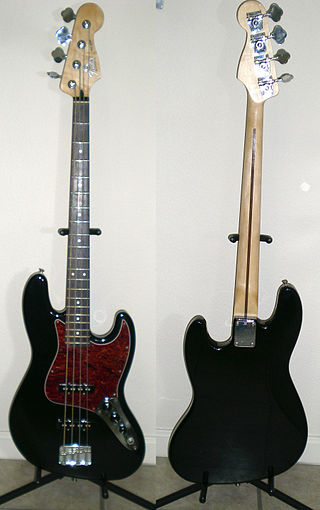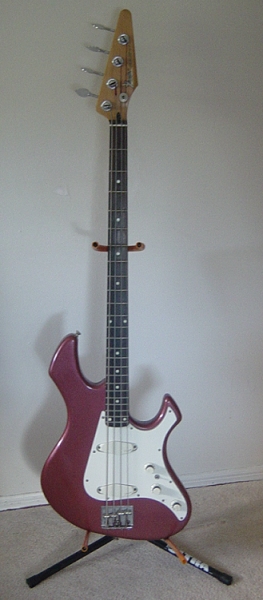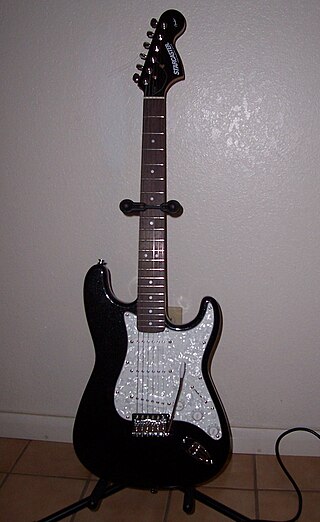
An electric guitar is a guitar that requires external amplification in order to be heard at typical performance volumes, unlike a standard acoustic guitar. It uses one or more pickups to convert the vibration of its strings into electrical signals, which ultimately are reproduced as sound by loudspeakers. The sound is sometimes shaped or electronically altered to achieve different timbres or tonal qualities from that of an acoustic guitar via amplifier settings or knobs on the guitar. Often, this is done through the use of effects such as reverb, distortion and "overdrive"; the latter is considered to be a key element of electric blues guitar music and jazz, rock and heavy-metal guitar-playing. Designs also exist combining attributes of the electric and acoustic guitars: the semi-acoustic and acoustic-electric guitars.

The guitar is a stringed musical instrument that is usually fretted and typically has six or twelve strings. It is usually held flat against the player's body and played by strumming or plucking the strings with the dominant hand, while simultaneously pressing selected strings against frets with the fingers of the opposite hand. A guitar pick may also be used to strike the strings. The sound of the guitar is projected either acoustically, by means of a resonant hollow chamber on the guitar, or amplified by an electronic pickup and an amplifier.

The Fender Stratocaster, colloquially known as the Strat, is a model of electric guitar designed between 1952 and 1954 by Leo Fender, Bill Carson, George Fullerton, and Freddie Tavares. The Fender Musical Instruments Corporation has continuously manufactured the Stratocaster since 1954. It is a double-cutaway guitar, with an extended top "horn" shape for balance. "Stratocaster" and "Strat" are trademark terms belonging to Fender. Guitars that duplicate the Stratocaster by other manufacturers are sometimes called S-Type or ST-type guitars. Many prominent rock musicians have been associated with the Stratocaster for use in studio recording and live performances, most notably Eric Clapton, Buddy Holly, David Gilmour, Mark Knopfler, Jimi Hendrix, Stevie Ray Vaughan, Mark Speer and George Harrison.
The Fender Jaguar is an electric guitar by Fender Musical Instruments characterized by an offset-waist body, a relatively unusual switching system with two separate circuits for lead and rhythm, and a short-scale 24" neck. Owing some roots to the Jazzmaster, it was introduced in 1962 as Fender's feature-laden top-of-the-line model, designed to lure players from Gibson. During its initial 13-year production run, the Jaguar did not sell as well as the less expensive Stratocaster and Telecaster, and achieved its most noticeable popularity in the surf music scene. After the Jaguar was taken out of production in 1975, vintage Jaguars became popular first with American punk rock players, and then more so during the alternative rock, shoegazing and indie rock movements of the 1980s and 1990s. Fender began making a version in Japan in the mid-1980s, and then introduced a USA-made reissue in 1999. Since then, Fender has made a variety of Jaguars in America, Mexico, Indonesia and China under both the Fender and Squier labels. Original vintage Jaguars sell for many times their original price.

The Fender Precision Bass is a model of electric bass guitar manufactured by Fender Musical Instruments Corporation. In its standard, post-1957 configuration, the Precision Bass is a solid body, four-stringed instrument usually equipped with a single split-coil humbucking pickup and a one-piece, 20-fret maple neck with rosewood or maple fingerboard.

The Fender Jazz Bass is the second model of electric bass created by Leo Fender. It is distinct from the Precision Bass in that its tone is brighter and richer in the midrange and treble with less emphasis on the fundamental frequency. The body shape is also different from the Precision Bass, in that the Precision Bass has a symmetrical lower bout on the body, designed after the Telecaster and Stratocaster lines of guitars, while the Jazz Bass has an offset lower bout, mimicking the design aesthetic of the Jaguar and Jazzmaster guitars.
Variax was the name of a line of guitars developed and marketed by Line 6 between 2002 and 2023. They differed from typical electric and acoustic guitars in that internal electronics processed the sound from individual strings to model (replicate) the sound of specific guitars and other instruments. The maker claims it was the first guitar family able to emulate the tones of other notable electric and acoustic guitars. It also provided a banjo and a sitar tone. The Variax was available primarily in electric guitar models, but acoustic and electric bass guitar models have also been available in the past.
The Fender Lead Series was produced by the Fender/Rogers/Rhodes Division of CBS Musical Instruments. The series comprised Lead I, Lead II, Lead III and Lead Bass models.
A solid-body musical instrument is a string instrument such as a guitar, bass or violin built without its normal sound box and relying on an electromagnetic pickup system to directly detect the vibrations of the strings; these instruments are usually plugged into an instrument amplifier and loudspeaker to be heard. Solid-body instruments are preferred in situations where acoustic feedback may otherwise be a problem and are inherently both less expensive to build and more rugged than acoustic electric instruments.

The Fender Performer was an electric bass guitar released in 1985 and discontinued in 1987, assembled in the United States and Japan. A Fender Performer electric guitar was also available.

The Fender Coronado is a double-cutaway thin-line hollow-body electric guitar, announced in 1965. It is manufactured by Fender Musical Instruments Corporation. The aesthetic design embodied in the Coronado represents a departure from previous Fender instruments; the design remains an uncharacteristic piece of Fender history.
Tacoma Guitars was an American manufacturing company of musical instruments. It was founded in 1991 as a division of South Korean company Young Chang. Instruments were manufactured in Tacoma, Washington. The company and brand name were later acquired by the Fender Musical Instruments Corporation. The Tacoma plant closed, and production ceased, in 2008.
The Fender Bullet was an electric guitar originally designed by John Page and manufactured and marketed by the Fender Musical Instruments Corporation. It was first introduced as a line of "student" guitars to replace the outgoing Mustang and Musicmaster models.
Electric guitar design is a type of industrial design where the looks and efficiency of the shape as well as the acoustical aspects of the guitar are important factors. In the past many guitars have been designed with various odd shapes as well as very practical and convenient solutions to improve the usability of the object.
The Precision Bass Plus is an electric bass made by Fender Musical Instruments Corporation and designed by George Blanda in 1989. It was one of the first American-made Fender basses to feature a 22-fret neck, requiring the company to slightly oversize the body shape and lengthen the cutaways, which distinctly changed the overall look of the instrument. Other features included a solid alder or ash body, a 1-piece maple neck with rosewood or maple fingerboard, adjustable Lace Sensor Precision and Jazz pickups, Schaller deluxe die-cast tuning machines, 3-ply black, parchment or 4-ply brown tortoise shell pickguard, Schaller Elite fine-tuning bridge, 3-way toggle pickup switch, master volume, series/parallel push-push button for the neck pickup and master TBX tone. It was discontinued in 1993.
The Fender American Deluxe Series was a line of electric guitars and basses introduced by Fender in 1995 and discontinued in 2016. It was upgraded in 2004 and 2010 before being replaced by the American Elite series in 2016.

Starcaster by Fender is a range of instruments and accessories aimed at students and beginners, marketed by the Fender Musical Instruments Corporation from the early 2000s until at least 2011. As of April 2018, no products were being marketed under this brand.

Sigma Guitars is a guitar manufacturing brand originally released by C.F. Martin as a line of guitars at affordable prices to compete with the increasing number of imported guitars from Japan and elsewhere. The Sigma line was discontinued by Martin in 2007. The rights to the name were acquired by German company AMI Musical Instruments GmbH, which relaunched the brand with guitars being produced in China.
The Yamaha Corporation is a multinational corporation and conglomerate based in Japan with a wide range of products and services, predominantly musical instruments, motorcycles, power sports equipment and electronics.
The Fender Telecaster, colloquially known as the Tele, is an electric guitar produced by Fender. Together with its sister model the Esquire, it was the world's first mass-produced, commercially successful solid-body electric guitar. Its simple yet effective design and revolutionary sound broke ground and set trends in electric guitar manufacturing and popular music. Many prominent rock musicians have been associated with the Telecaster for use in studio recording and live performances, most notably Bruce Springsteen, Luis Alberto Spinetta, Keith Richards and George Harrison.










